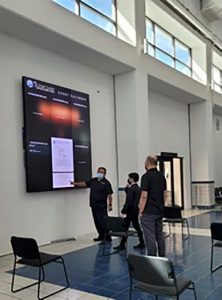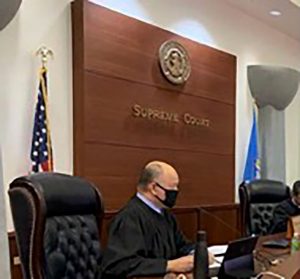A man with a mission

CNMI Supreme Court Justice John A. Manglona is a man with a mission—he wants to continue to be a part of the bench so that he can work with his fellow justices to achieve the goals of modernizing CNMI court operations and spearheading community outreach projects.
Seeing these goals come to fruition has taken much of Justice Manglona’s time and energy both on and off the bench, aside from hearing hundreds of cases and authoring opinions both in the Commonwealth Supreme Court and the Supreme Court of Guam. And his continuing desire to contribute is what drives him to run for another retention.
Justice Manglona is a 22-year veteran of the CNMI high court, having first served as an appointee of former governor Pedro P. Tenorio in 2000 to the Superior Court as an associate judge, While serving as a judge, then-Guam Governor Carl Gutierrez also nominated Manglona as a designated justice of the Guam Supreme Court for a four-year term. In 2000, Manglona ascended to the CNMI Supreme Court to become an associate justice.
This is his third time to seek retention for another eight-year term. Manglona was first retained by 75% of voters in 2007 and by 78% in 2014. His current term expires in May, 2024
Manglona’s desire to continue being a public servant is deep. In his letter of intent he says, “In the past 22 years as a Supreme Court justice, I have worked diligently to serve the interests of our island community. I want to extend my sincere appreciation to all voters whose voices provide the guiding light in our islands. I eagerly await the electoral process and the prospect of further judicial service.”
Born on Rota, Manglona attended Guam Catholic schools and graduated from Father Duenas Memorial School. He received his B.A. in Political Economy from the University of California, Berkeley, and graduated from Creighton University School of Law (J.D.) and the University of the Pacific, McGeorge School of Law (LL.M. in Taxation).
Prior to his appointment to the bench, Manglona was in private practice, focusing on probate, corporations, tax, and real property transactions.
Manglona is married to U.S. District Court for the NMI Chief Judge Ramona V. Manglona, and they have two children..
Saipan Tribune recently sat down with Manglona to talk about his advocacies on and off the bench and his accomplishments during his first two terms as an associate justice.
On improving court operations, “Modernizing our courts is very important,” Manglona says, so he has taken leadership roles in some committees while also serving as an advocate and an adviser on some, providing guidance and expertise to the judiciary committees tasked to do the job.

Manglona is proud of the court’s accomplishments during these past eight years, He refrains from listing one specific project or program over another since all of the parts of the court that were modernized play an important role in the delivery of judicial services. But overall, he says, the successes can be fully credited to the work of the project committees that are made up of administrative and bench leadership, as well as dedicated staff. Some of the key committees involved in modernization were strategic planning, court technology, e-filing, e-recording, court rules, court security, and infrastructure improvements.
Modernization of court systems was at the very heart of the Judiciary’s five-year strategic plan, which has been implemented since 2018. Manglona says that capital improvement projects at the Guma’ Hustisia were undertaken under this plan. These included an upgraded security and screening zone (SSZ). With funding from the federal CARES Act, Manglona spearheaded the SSZ building committee to complete the Guma Hustisia’s building extension—a task that was done in less than six months at the height of the pandemic. The building has the latest built-in sanitizing equipment and scanning technology—important features for a building that processes approximately 5,000 visitors monthly.
Manglona also actively participates in the work of the court’s technology team, which is currently working on a major revamp of the technology infrastructure. Aside from enhancing connectivity that will allow for greater speed and clarity in virtual court hearings on all three islands. Manglona is also excited to see the outcome of audiovisual enhancements in all courtrooms, which is anticipated to be implemented in 2023.
There is even more exciting news ahead. This November, the Judiciary will finally be implementing an electronic land recording system. Manglona says this is one of the most innovative land documents recording systems in the Pacific region, bringing tremendous convenience to the public in keeping track and accessing land records and documents. This technological enhancement was made possible through the efforts of the court’s e-recording committee.
Manglona is also deeply involved in one of the Judiciary’s major infrastructure improvement—the Data Center. Aimed at meeting the growing needs of the Judiciary’s new age technology systems, the Data Center is set for completion in late 2023. The facility will provide a secure environment for the court’s new IT equipment and network infrastructure.
Nearest and dearest to Manglona’s heart are several programs that the Judiciary implements for the community’s benefit. Off the bench, the associate justice has, for over 20 years now, contributed as a judge and coach at speech and debate competitions. He actively assists with the high school mock trial program as well.
According to Manglona, there are current plans for an in-person mock trial competition to be held in February 2023, after being off for two years during the pandemic.
“I sometimes worry that our students may think they are not as good as students on the mainland,” Manglona said. “…Maybe we don’t have the resources of mainland schools, but I want people to know that some of my fondest memories include coaching mock trial and ‘We the People’ teams at national competitions in Washington, D.C. and watching our NMI students hold their own against the best in the country. We have a lot of very talented students.”
Manglona is also proud of his participation in the Judiciary’s Summer Pre-law Program, which he has helped plan since 1991.“I have witnessed firsthand the benefits of having our residents attend this program and later go on to law school and return to serve our island in many capacities.”
In fact, the Judiciary’s pre-law committee ran a successful program this past summer with a group of 19 students, most of whom have expressed interest in applying to law school.
The associate justice also sees the importance of bringing Supreme Court hearings to schools so that our youth can observe firsthand how the justice system works. “In recent years, we held oral arguments at Kagman High School, Marianas High School, Saipan Southern High School, and Mount Carmel School. The students make a great audience. I hope they find inspiration in seeing some very fine lawyers stand and argue their cases. On Rota and Tinian, we invited and interacted with students in the courtrooms. We will continue to reach out to our youth—to listen to them, understand their viewpoints, and answer their questions.” Manglona said.
The Law and the Freshman Legislator program, which he started in 2002, is another program near and dear to Manglona’s heart. “I think it’s very important and it provides a real benefit to all residents.”
The associate justice introduced the program in 2002 after talking to the chief justice of the Washington State Supreme Court. Designed to provide first-term legislators with an overview of the Constitution, the Covenant, the rules for statutory construction, and how to tap into legal research and resources, the program has consistently received favorable evaluations.
“I believe it helps our legislators carry out their duties,” Manglona said. “Plans are currently in the works to offer the programs in January 2023 for what could possibly be the largest-ever incoming group of freshmen legislators.”
Thanks to the funding support of the Judiciary, the CNMI Bar Association, and the Public School System, these community programs continue to thrive. But despite the successes, Manglona said the programs still face funding woes and the need to find enough volunteers to keep them going year to year.
“I am very grateful for the support we have had over the years from people willing to serve as volunteers. Without volunteers, many of these programs will not continue. So far we have had good luck finding volunteers, and I remain hopeful that these successful and exciting programs will continue long into the future,” Manglona said.
The CNMI Judiciary: Pre- and post-pandemic
Similar to organizations that want to stay at the forefront of their industry, the CNMI Judiciary believes that continuous improvement is the way for the courts to be efficient and effective in carrying out its mandate of serving the public. With the Judiciary’s Strategic Plan in place, and backed by funding from the ARPA and CARES Act, the automation and computerization of court systems became a reality.
“In 2014, the Judiciary lacked the resources and manpower to improve our severely outdated technology systems. Our IT division only had about two employees servicing court facilities on Saipan, Tinian and Rota. Our computer systems were outdated.” He says these all changed with the infusion of federal funding. One upgrade that has proven to be advantageous was equipping court personnel with their own laptops. With this, Manglona says, the court continued to operate virtually even during times of closure.
While the Judiciary has made great strides in improving court technology at all levels and areas, Manglona says procuring technology can be challenging because of supply chain issues. But he remains optimistic that the Judiciary will eventually procure equipment and supplies in the coming months.
A legacy of the pandemic that Manglona says will continue to be practiced in court are virtual proceedings, including the initial stages of criminal proceedings. This also happens to be included in the Judiciary’s five-year Strategic Plan. “We have parties, witnesses, and attorneys living and traveling in all parts of the world, with different schedules and responsibilities, so continuity of virtual hearings ensures greater access to justice,” he said.
As part of efforts to align its processes with other jurisdictions, Manglona says the Judiciary has also made some institutional changes through programs set up during the pandemic. This include the establishment of a Mental Health Court Docket to fulfill an order issued by the Supreme Court in 2021. Plans are also underway for a Veterans Court docket. Both programs supplement the successful Drug Court treatment program, which has been found to be effective in dealing with substance use and mental health issues in the justice system.
The results of the recent evaluation by the CNMI Bar Association showed the need to immediately act on the need for professional development of bench members and court staff. In response, Manglona says the Judiciary will continue to enhance its training programs to address this and other concerns of the NMI Bar Association. “We welcome such evaluations and other input as we all aim at maintaining a firm and effective court system.”
While Manglona underscores the importance of advanced technology, improved buildings, successful programs and increased personnel in court operations, he says his main obligation and steadfast resolve are to interpret and apply the law impartially, fairly, and promptly.




